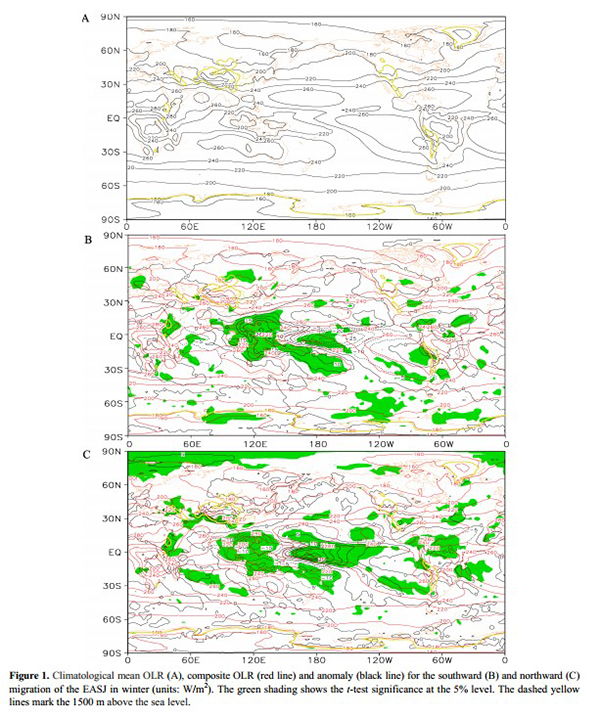最新科研进展
Correlation between meridional migration of the East Asian jet stream and tropical convection over Indonesia in winter
Authors:
Hui Yang1, Yuanfa Gong2 and Gui-Ying Yang3
1 International Center for Climate and Environment Sciences, Institute of Atmospheric Physics, Chinese Academy of Sciences, Beijing, 100029, China
2 Plateau Atmosphere and Environment Key Laboratory of Sichuan Province, Chengdu, 610225, China
3 National Centre for Atmospheric Science, and University of Reading, Reading, RG6 6BB, United Kingdom
Abstract:
The relationship between tropical convective activities and meridional (north-south) migration of the East Asian jet stream (EAJS) in winter (December-February) is investigated for improving our knowledge of processes affecting the meridional migration of the EAJS. The monthly mean fields of outgoing longwave radiation (OLR) produced by NCAR and monthly atmospheric circulations produced by the NCEP/NCAR are used in this study. For 31 winter seasons between 1980 and 2011, the meridional migration of the winter EAJS is found to be strongly correlated with the present and preceding conditions of tropical convection over Indonesia. The anomalies in the tropical convection over the region in the preceding autumn and even preceding summer are a very useful indicator for the abnormal meridional migration of the wintertime EAJS. When the tropical convection over Indonesia weakens (strengthens), the EAJS has an abnormal southward (northward) migration. The atmospheric circulation associated with the abnormal meridional migration of the EAJS features abnormal air temperatures over the EAJS and its south side. The center of abnormal air temperatures occurs over the region south of the Yangtze River. Abnormal air pressures generated by abnormal air temperatures lead to abnormal winds. In the case of weakened tropical convection (positive OLR anomaly) over Indonesia, ascending motion of air mass over Indonesia is reduced, and the strength of Hadley circulation is weakened over the meridional range of the western Pacific Ocean. Consequently, the high-level air mass to the south of the core of the EAJS abnormally ascends and cools and the nearly southerly divergent winds at high-altitudes weaken, leading to significant reduction of heat transport from tropics to the southern China, with negative anomalies of air temperatures in the EAJS and its south side. The above processes increase thermal winds to the south of the Yangtze River and enhance the high-level westerly winds. To the north of the Yangtze River, both thermal winds and the high-level westerly winds are reduced. As a result, the EAJS has an abnormal south migration. In the case of enhanced tropical convection (negative OLR anomaly) over Indonesia, the opposite happens, in which Hadley circulation strengthens, the air mass to the south of the core of the EAJS abnormally descends and warms, heat transport increases from tropics to the southern China with positive air temperatures anomalies over the EAJS and its south side, and the EAJS has an abnormal northward migration.
Key words:
East Asian jet stream, meridional migration, tropical convection, Indonesia, Hadley circulation, temperature anomaly

Citation:
Hui Yang, Yuanfa Gong and Gui-Ying Yang, 2017: Correlation between meridional migration of the East Asian jet stream and tropical convection over Indonesia in winter. Satellite Oceanography and Meteorology, vol.2(1): 60–74. http://dx.doi.org/10.18063/SOM.2017.01.006.
